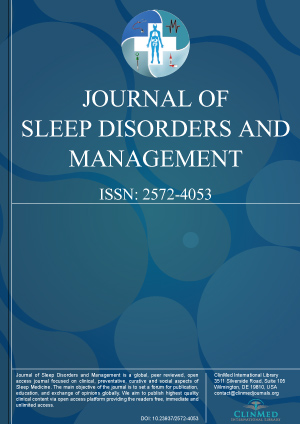Open Access DOI:10.23937/2572-4053.1510027
Vitamin B12 and Circadian Rhythm Sleep Disorders: Patient Treatments vs. Controlled Studies
Behrooz Kamgar-Parsi, PhD
Article Type: Commentary | First Published: December 30, 2019
Despite earlier reports of success, controlled studies have not confirmed the effectiveness of vitamin B12 in treating circadian rhythm sleep disorders. We try to explain why these two types of studies do not produce similar results. Individuals with circadian rhythm sleep disorder suffer from recurrent patterns of disrupted sleep that can significantly affect their daily functioning. Evidence suggests that vitamin B12 supplements may have a beneficial effect on sleep patterns. However, researc...
Open Access DOI:10.23937/2572-4053.1510026
Cluster Analysis and Phenotyping Based on Association of Sleep Studies and Cardiovascular Comorbidities
John Arek Kileci, Derya Arkonac, Leslie Seijo and Alfredo Astua
Article Type: Research Article | First Published: August 28, 2019
Obstructive Sleep Apnea (OSA) is a complex disease process with a known significant association with cardiovascular diseases and the metabolic syndrome. This study aimed to define phenotypes of OSA based on sleep studies and cardiovascular comorbidities and to further investigate whether there would be any meaningful association between these disease processes. Defining phenotypes could assist in individual targeted treatments for patients with OSA....
Open Access DOI:10.23937/2572-4053.1510025
Chronotherapy for the Treatment of Hypertension among Patients with Obstructive Sleep Apnea: A Systematic Review
Magdalena Deaton, MPH, MSN, RN, AGNP-C, Jeanne Ruff, MPH, BSN, RN and Lisa Boss, PhD, RN, CNS, CEN, CNE
Article Type: Research Article | First Published: July 26, 2019
Hypertension (HTN) and obstructive sleep apnea (OSA) are associated with increased risk for adverse cardiovascular events. Comorbid HTN with OSA is often resistant to pharmacologic treatment. Chronotherapy, the timing of treatment based on circadian rhythms, may prove to be a valuable, cost-effective tool for improving blood pressure (BP) control among those with OSA. This Systematic Review appraises the existing literature regarding morning (a.m.) vs. evening (p.m.) administration of antihypert...
Open Access DOI:10.23937/2572-4053.1510024
Epileptiform Activity in Patient with RBD-Like Symptomatology
Isabel Loucao Amorim, MD, Linda Azevedo Kauppila, MD, Mariana Reis Costa, MD, Carla Bentes, MD, PhD, and Rita Peralta, MD
Article Type: Case Report | First Published: July 06, 2019
REM sleep behavior disorder shares some clinical similarities with nocturnal epileptic seizures, which can result in misdiagnosis. We report a case of a man with Parkinson Disease diagnosis and parietal and frontal meningiomas who started to have abnormal sleep behaviors, suggestive of REM sleep behavior disorder. Video-polysomnographic showed periodic bilateral occipital epileptiform activity that occurred near arousals, where subtle movements were detected. During REM sleep no loss of atonia n...
Open Access DOI:10.23937/2572-4053.1510023
Observations on Restless Legs Syndrome and Indications of the Cause
Melrose Truett Garrett, Jr. Sc.D
Article Type: Short Note | First Published: June 24, 2019
RLS accompanying loose stool (not diarrhea) indicated two hypotheses: 1) Medications for diarrhea will relieve RLS, 2) RLS is caused by pressure in the colon blocking a femoral vein, the nervous system then causes muscle contraction in the leg. In tests both were sustained. Soluble fiber corrects loose bowels but the number of Americans with insufficient fiber is much greater than those with RLS....
Open Access DOI:10.23937/2572-4053.1510022
Novel Anti-Snoring Mouthpiece to Reduce Snoring in At-Home Study
Jonathan Greenburg, DDS, Jesse Cozean, MBA and Colette Cozean, PhD
Article Type: Clinical Trial | First Published: June 10, 2019
Habitual snoring affects millions of individuals and their partners, but often goes unresolved due to the high cost of care and other barriers to treatment. The purpose of this study was to evaluate the effectiveness of a novel intraoral device that restrains the tongue in an overthe- counter setting in a population of habitual snorers. Individuals who self-reported snoring enrolled in the study and were sent an investigational device. After signing the informed consent, they completed an initia...
Open Access DOI:10.23937/2572-4053.1510020
Is Post-Operative High Dependency Admission Required for Children with Obstructive Sleep Apnea after Adenotonsillectomy?
Chu Qin PHUA, Yi Rong Leonora LIU, Pei Yuan FONG, Kay Yee Winnie FUNG and Kun Kiaang Henry TAN
Article Type: Retrospective study | First Published: April 29, 2019
The commonest cause of paediatric obstructive sleep apnoea (OSA) is the disproportionate adenotonsillar hypertrophy in relation to craniofacial growth and airway calibre. In recent years, there is an increasing awareness of paediatric OSA, leading to increasing number of adenotonsillectomy being performed for this indication. Adenotonsillectomy has been shown to confer improvement in child behaviour and quality of life. In up to 79% of patients, it can lead to normalisation of polysomnography......

